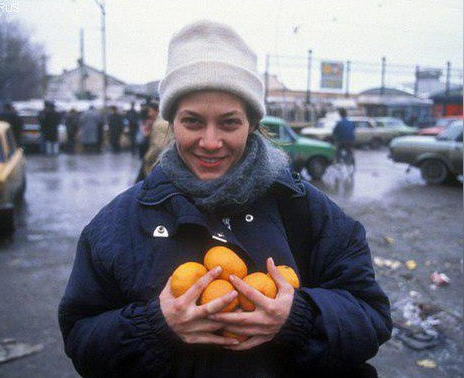The photo in this article captures 28-year-old American photojournalist Cynthia Elbaum on December 21, 1994. Despite the approaching combat, she went into the still-operating market in the center of Grozny and bought juicy, bright orange mandarins. According to an old Soviet tradition, New Year’s gifts were not considered gifts without them, and a festive table looked poor if it only had other foods and drinks. Growing up in a family of immigrants from the former Soviet Union and being fluent in the Russian language, she adopted this tradition as well. Some colleagues took her photo when she, childishly pleased with her purchase, emerged from the market stalls.
The next day, Cynthia Elbaum was killed by a Russian bomb. She was destined to welcome the new year in a zinc coffin on the way back from war-torn Chechnya. The photograph of her, with mandarins in her hands, turned out to be the last snapshot of her life.
The journalist died in the presence of many people, both locals and her colleagues. According to their testimonies, it happened around 11 a.m. Cynthia Elbaum was standing near a house destroyed in a night bombardment, interviewing the victims when the sharp sound of low-flying planes and explosions rang out. The dust settled, revealing a horrific scene of a mixture of shredded human bodies and bloody snow, between the smoking craters. Up to 20 people perished in that raid. Cynthia Elbaum was thrown far aside by the blast wave. Her entire body was cut by shrapnel, but the wounds on her head were particularly gruesome. Locals wrapped her remains in a carpet and placed her in a hastily assembled coffin. On the same day, with the help of Chechen fighters, colleagues and friends transported the killed journalist to neighboring Dagestan, from where she was flown to Moscow and then home to America.
The memory of Cynthia Elbaum lives on in Chechnya. She was the first foreigner to be counted among the casualties in the republic. However, the first victims of the horrific war were Chechen television journalists Hussein Guzuev and Gelani Charigov. A few days after Cynthia Elbaum’s death, also in Grozny, cameraman Bilal Akhmadov was killed, and the list continued to grow at an increasingly catastrophic rate. By the end of 1996, when the first Russo-Chechen war ended, the list included more than two dozen names—Chechens, Russians, and foreigners alike.
The second Russo-Chechen war, starting in 1999, doubled and even tripled this list, although it is impossible to ascertain exactly how much it increased. The geography of killings related to Chechnya, as well as the circumstances under which they occurred, changed. Counting became more difficult. Anna Politkovskaya, who often took risks as a war correspondent, was shot and killed, point-blank, outside of her own Moscow apartment. Elina Ersenoyeva and Ali Astamirov were abducted and disappeared. The former was taken from her home in Grozny in 2006, and the latter was seized by armed individuals in the territory of neighboring Ingushetia in 2003. There is no doubt that both have long been killed. But if there are no bodies, relatives keep searching, and they keep their names on a completely different list—the list of missing persons.
A short film about Cynthia Elbaum was made in the United States. Seven rolls of film found on her after her death were developed and printed. Her photographs have been exhibited multiple times, and her name is immortalized on the obelisk at the Newseum in Washington.
The keepers of the memory of Chechen and Russian journalists are primarily their relatives and colleagues. In Chechnya today, speaking the truth is impossible, and in Russia, people have not been particularly fond of remembering outsiders. However, much information about the deceased journalists is collected at the Natalya Estemirova Documentation Center (NEDC) based in Oslo. Some of these materials can be accessed at: https://www.nedc-nhc.org/
Contact us
Employee
